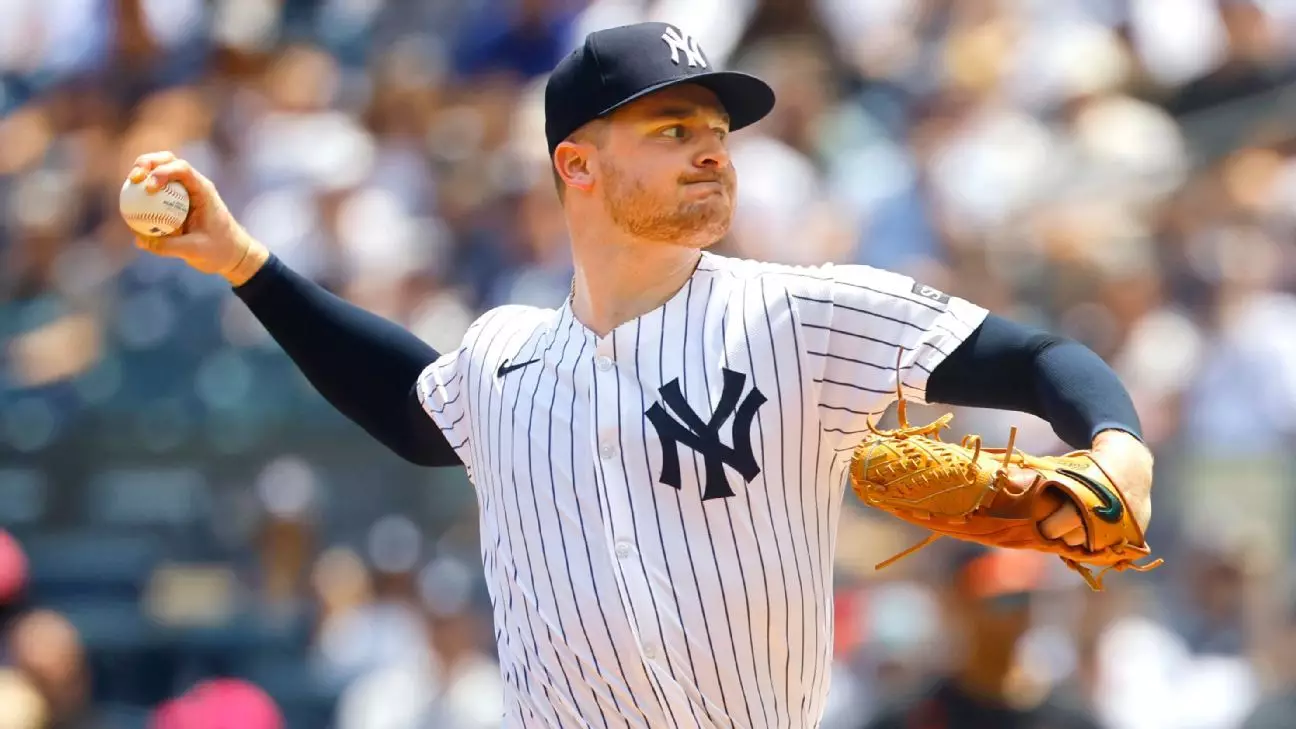In the relentless world of Major League Baseball, few injuries hit harder than the dreaded Tommy John surgery, a devastating blow that can halt a pitcher’s career in its tracks. The New York Yankees, a franchise with a storied history of resilience, now face an ongoing crisis with their starting rotation. The latest blow comes in the form of Clarke Schmidt, whose promising season has been abruptly derailed by a severe elbow injury. This development not only threatens his future but also leaves the Yankees scrambling to find stable replacements and maintain competitiveness amidst turmoil.
The injury, diagnosed as a torn ulnar collateral ligament (UCL), has cast a shadow over Schmidt’s career trajectory. Once viewed as a bright spot in the Yankees’ pitching staff, his fourth season in the majors showed promise—an ERA of 3.32 across 14 starts, signaling that he had evolved into a reliable force on the mound. However, the injury not only curtails his current season but also raises serious questions about his long-term prospects. Having endured Tommy John surgery previously in 2017, this setback feels even more personal and daunting for the 29-year-old pitcher. It’s a cruel twist of fate for someone who had begun to fulfill potential that many believed could elevate the Yankees’ rotation to a new level.
The timing couldn’t be worse for New York, already battered by injuries to key starters. Gerrit Cole’s absence due to his own Tommy John procedure, coupled with Luis Gil and Ryan Yarbrough’s injuries, has resulted in a depleted staff that struggles to fill innings consistently. In such a climate, the loss of Schmidt compounds the Yankees’ challenges, threatening to push the team further into instability just before the crucial stretch of the season and the upcoming trade deadline.
The Human Side of a Professional Setback
Schmidt’s story embodies the harsh reality faced by professional athletes: relentless physical tolls, setbacks, and the difficult fight to return stronger. After exiting Thursday’s game after just three innings due to discomfort, Schmidt recognized that something was seriously wrong. His subsequent MRI confirmed the worst-case scenario, and while he is seeking additional medical opinions, the prognosis remains bleak—surgery appears inevitable. For Schmidt, this marks a personal battle that extends beyond mere statistics; it’s a test of resilience, mental toughness, and perseverance.
The emotional toll on players like Schmidt is often overlooked amid team analytics and season standings. Witnessing a talented pitcher, peaking with promise, face a career-altering injury can be heartbreaking. The Yankees now must navigate the delicate balance of supporting an athlete through recovery while also addressing the immediate team needs. The internal options—veterans like Carlos Carrasco and Allan Winans, along with young prospects such as Cam Schlittler—highlight the depth challenge the Yankees face. Yet, none can fully replicate the consistency and proven ability Schmidt provided.
This injury also serves as a brutal reminder of the physical gamble inherent in pitching at the highest level. For all the hours of preparation and conditioning, the human body remains vulnerable. The team’s medical staff must now focus on maximizing recovery, but the reality is that Schmidt’s return next season may be uncertain. Such setbacks underscore the importance of long-term planning and adaptability, especially during a season that demands resilience to stay afloat.
Strategic Rebuilding and the Path Forward
Faced with a sudden injury crisis, the Yankees are confronted with strategic choices. The immediate focus shifts to patching the rotation for upcoming starts before the All-Star break. Veterans like Carlos Carrasco, with extensive experience, and the young, promising Cam Schlittler are likely to be called upon to fill the gap. Yet, relying on internal options alone may not suffice for a team that envisioned competing at a high level all season.
The looming trade deadline adds further pressure. The Yankees are expected to explore avenues to bolster their rotation, possibly acquiring proven arms from outside the organization. The uncertainty surrounding Schmidt’s recovery underscores the urgency of this pursuit. With high-stakes games approaching, the Yankees will need to find pitchers who can deliver quality starts and maintain their playoff hopes.
However, the emphasis should not merely be on immediate fixes. The team must also reflect on the sustainability of its pitching staff. The recurring injuries reveal vulnerabilities that require long-term solutions—whether through smarter workload management, pitching analytics, or strategic roster construction. Cultivating depth and resilience in the rotation is essential if the Yankees are to emerge from this crisis with their aspirations intact and their young talent unharmed.
Schmidt’s injury encapsulates the brutal realities of baseball—a sport where hope can be shattered overnight, yet resilience must prevail. The Yankees’ response to this adversity will define their season and perhaps their future. While the road ahead is challenging, it also offers an opportunity to reassess, rebuild, and reaffirm their commitment to excellence, no matter the setbacks they encounter.

